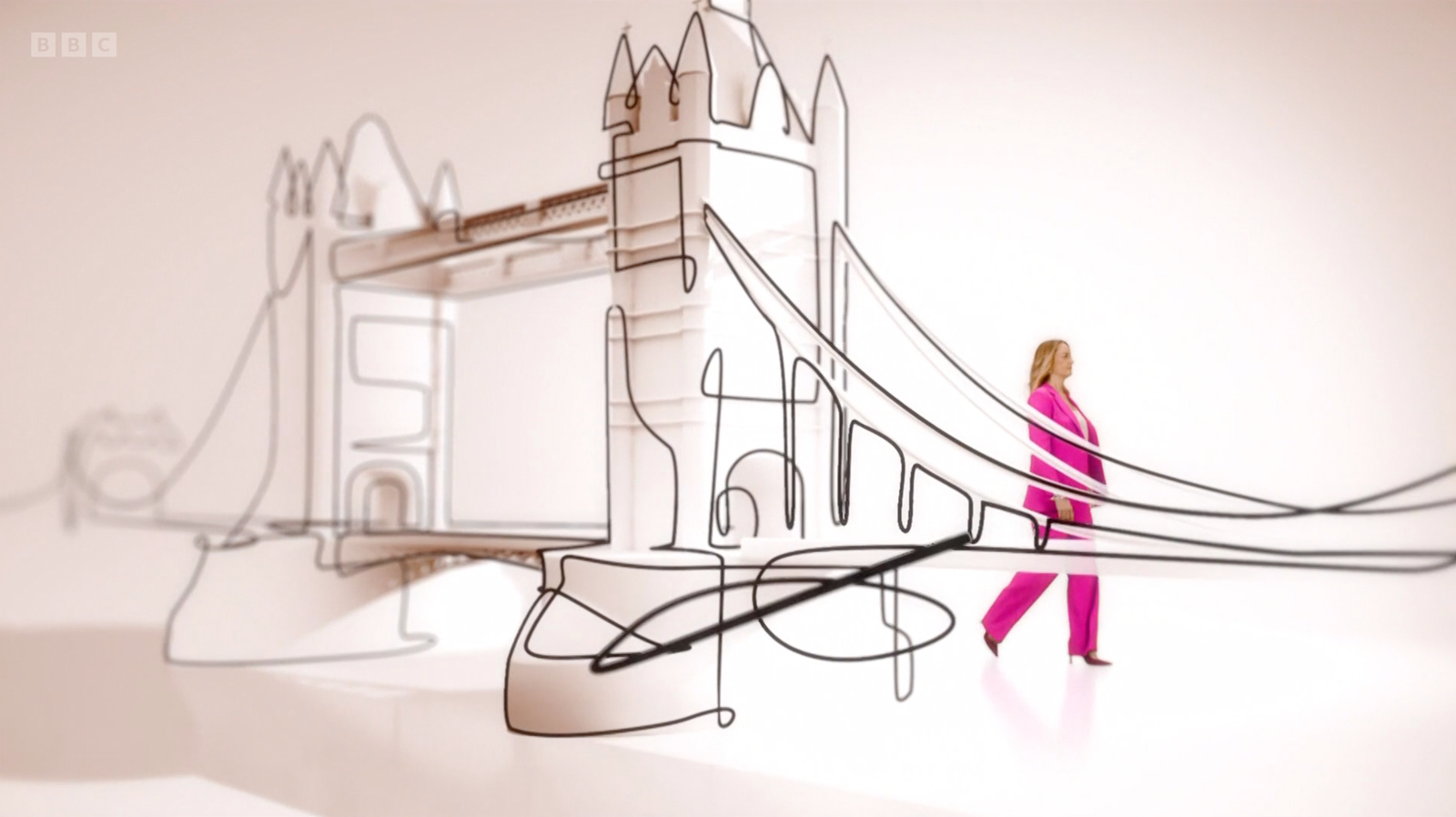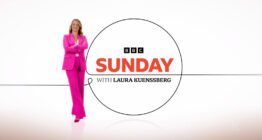BBC brings unique style to Sunday political affairs show

Subscribe to NCS for the latest news, project case studies and product announcements in broadcast technology, creative design and engineering delivered to your inbox.
BBC News debuted an overhaul of its Sunday morning political affairs show “Sunday with Laura Kuenssberg” earlier this year from the updated Studio B using a standout look – mixing a hand-drawn style blended with 3D elements in a variety of ways.
That style is prominently featured in the show’s title card, which features the BBC logo atop a bold red-orange “Sunday” set in the bespoke BBC Reith sans serif and Kuenssberg’s name in the serif version.
Kuenssberg herself stands on one side of the screen, making it appear as if she was shot against a white cyc, though the entire look was likely accomplished using compositing or chroma key.
Meanwhile, a line enters from the left side of the screen, does a quick little curl before heading downward to create a mostly complete circle around the logotype elements. Right before it closes the circle, the line takes a quick turn to the right and cuts through the typography lockup, dividing “Sunday” from the host’s name before heading off-screen to the right.

A secondary element is an icon-style look created by merging the letters “L” and “K,” the host’s initials, in red and gray and surrounded by a similar circular line. This element appears on video walls and on-screen graphics as well as the show’s bug.
The sharp angles in the “K” are used in both the upper part of the “L” in the emblem as well as transitional elements and accents in the upper right and lower left of the screen during teases.

The title card is the final view of a series of scenes that feature Kuenssberg walking through a series of U.K. landmarks created using a combination of monochromatic 3D elements and the line motif, with many elements appearing to be drawn out by an invisible pen tracing over select parts of the more detailed depictions of structures behind it.
In many cases, multiple invisible pens draw out different portions of the lines, typically with each one forming a portion of the drawing without being lifted, creating the feel of single-stroke drawings (although, in this case, it’s multiple single strokes).
The opening scenes also have a distinct pinkish tint that is intensified by the soft shadow effects on the 3D buildings.
For music, a casual tune appears to convey the sense of a leisurely stroll through the city, as opposed to the hard-hitting or majestic music frequently used on Sunday morning political affairs shows.
Meanwhile, the show takes full advantage of Studio B’s plentiful video walls to create a bright and airy background featuring more views of London landmarks.
Here again, the design relies on 3D elements that have been traced by the line drawing. The skyline created isn’t geographically realistic, but rather meant as a composite of various iconic buildings from around the country.

For example, Kuenssberg’s primary one-shot background features the London Eye to the left and Spinnaker observation tower camera right, the latter of which is in Portsmouth, a good 70-plus miles away.
Other featured structures include London Bridge and Tower Bridge in London, Scotland’s Forth Bridge and Kelpies horse sculptures, the houses of parliament and Stonehenge, among others.
All of these skylines are set under a sky that starts blue toward the top of the two-story studio before transitioning through a variety of pinks, oranges and violets and accented with wispy clouds.

Kuenssberg starts off the show in front of Tower B in the center of the studio, which, quite appropriately for its shape, showcases Elizabeth Tower, the tall structure that houses the famous Big Ben bell, with the two in-studio guests seated on the catwalk camera left.
She then moves over to the primary anchor desk near Tower A, which features a blurred 3D skyline without any drawing elements that are divided roughly in half by the “LK” icon and the hand-drawn line that surrounds it.
In an example of attention to detail, the horizontal line that divides the skyscape from the white block above is slightly lower on the left side, following the same positioning as in the logo and fullscreen iterations of the initialism.
The design also has the entire circular element filled in with white, meaning a curved portion sticks down slightly into the sky, creating a sort of jigsaw puzzle-like look.
The front of the curved desk boasts the show’s logotype with a horizontal line under the word “Sunday” with a small loop just before the word starts.
Panel members sit with Kuenssberg at the desk but, like on other BBC programs using Studio B, she gets up from her seat here and walked over to the catwalk area to interview guests before walking back to rejoin the panel, an interesting segue that illustrates her volleying back and forth between interviewees and analysis.
During interviews, the video wall on the catwalk can be used to insert key data points for Kuenssberg and guests to refer to as appropriate.
“Sunday” also unveiled its own unique lower third design — a simple look that features an off-white primary bar and red-orange lower one, with a sans serif used for the person’s name and a serif used for titles under it. These also use a full-color “LK” icon as a dividing element to the far right, where, when inserted, aligns perfectly with the bug. Here too slightly different levels are used, so the colored lower tier becomes slightly taller on the very far right and the white circle sticks down into it.
“Sunday” has its roots in “Sunday AM” and “The Andrew Marr Show,” which aired from Studio 54D on BBC One from 2005 to 2021, when host Andrew Marr departed.
“Tonight with Andrew Marr” would debut the following year on LBC radio.
In the meantime, BBC switched the show’s title to “Sunday Morning” and announced Kuenssberg as the new host, though a series of presenters filled in after Marr left. The show continued using the Marr era look with the logotype swapped out until the overhaul.
Subscribe to NCS for the latest news, project case studies and product announcements in broadcast technology, creative design and engineering delivered to your inbox.






tags
BBC, BBC News, Political, studio b, Sunday with Laura Kuenssberg
categories
Broadcast Design, Graphics, Heroes